The Butler bloodline has had a pronounced effect on the Texas Longhorn industry for the past several years. Through the use of artificial insemination and embryo transfer, the once-rare Butler blood is being infused into numerous Longhorn herds. To gauge the impact, we talked to 23 Texas Longhorn breeders throughout the country.
Most of these ranchers have used Butler cattle extensively in their breeding programs. We asked them specifically how they are working Butler blood into their herds and what the outcome has been. Following are their comments.
 F.M. "Blackie" Graves, Dayton, Texas
F.M. "Blackie" Graves, Dayton, Texas
Blackie, owner of Classic (with Red McCombs) has had Butler cattle since 1962, and the name Blackie Graves is probably more closely associated with the Butler bloodline than any other. (See Homespread, May/June 1984). Speaking of Classic, Blackie says, "I don't know if there'll ever be another bull with that much horn growth (61 inches), or if there'll ever be another family of bulls that gives such fast horn growth. You know, I hope Classic outbreeds himself. Every great sire should.
I've found breeding these cattle that, say, one year you'll get a lot of color and the next year you'll get a lot of solids. Using Monarch and Classic, I'm getting them whiter all the time. But I do breed for color. I've got a dark blue son of Man O'War, and Dode's Boy, a Conquistador son, that I'm getting color with.
"I raised the cow Ghost; Sam was her daddy. Since I sold her, she's worked great in embryo transfer. Bold Ruler is a bull that I bred, and I sold him to Darol as a calf. He didn't come straight out of the Butler herd like Classic and Monarch, but he was out of my herd that was started with Butler cattle in '62.
Johnny Hoffman, Metairie, Louisiana
"I started in the business in 1977 and my first cows were Peeler, Yates and WR. Then I met Blackie Graves at my first TLBAA convention, in San Antonio. I went and looked at his cattle, and they were the greatest bunch of cattle I ever laid eyes on. I bought some cows from him then, and two bulls - Red Bird and Prince Classic."
Leonard Stiles of King Ranch is leasing Prince Classic now. Johnny also owns pure Butler sire Classic Majestic (by Classic, out of Graves 68) and owns half-interests in Dixie Hunter (by Classic out of Red Rose) with Lamb-Sparger, and Monarch (by Bevo out of Lady Butler) with Blackie Graves.
"The bulls have high libido. All three bulls produce quite a bit of color, and I'm very pleased with the conformation. I would say the Butler cattle have a disposition that is out of this world. They're easy to handle, not wild. All that I've had are great producers, great breeders and milkers."
Melvin Jones, Houston, Texas
"I got into the Longhorn business in 1981, and eventually I met Jack Phillips and J.W. Isaacs and bought some cattle from them. I met Ruel Sanders and borrowed Bevo, Jr., who is out of a lineback Butler cow. He's a lineback like his sire, Bevo. I'm using Bevo, Jr., ad Bimbo, who's also by Bevo and out of Lineback III, another Butler cow.
"I like the type horn of Butler cows, and the coloration and conformation of Bevo. I like the lineback like he was. And I like the twist in the horns that Bevo had. I would must rather have a good twist than a huge tip-to-tip hornspread."
Owen McGill, McGill Ranch, Wheatland, Wyoming
"I thought he was the best Longhorn bull I'd ever seen." That was Owen McGill's first and lasting impression of Bold Ruler. Darol Dickinson had bought the bull from Blackie Graves, who raised him. Owen McGill and neighboring rancher Jimmie Grieve went into partnership on the bull and brought him home to Wyoming.
Says Owen, "I think he's a great bull, myself. He had the most horn of any bull there was at that time. He was a smooth kind of bull for a Longhorn, that crossed good with commercial cattle. I think Bold Ruler's calves have better conformation than those of any other Butler bull. We sold quite a few good herd sire prospects out of Bold Ruler, and they brought real good prices.
"We've kept all the top Bold Ruler heifers for our foundation herd. We never had one that wasn't a good milker. They're more consistent producers than any other bloodline."
Ruel Sanders, Bar R Ranch, Magnolia, Texas
"My family has had Longhorns since my dad was a kid. I got my Butler cattle from the Hockley Livestock Auction near Hempstead. My friend Pete Jones called and told me there were some Butler cattle for sale. I bought six cows and one bull, Bevo (father of Classic). I used him until 1980, and we let DeWitt Meshell have him. I've got some daughters and Bevo II out of him."
Ruel never sold any of his Butler cattle until he sold a bull at the 1983 Gulf Coast sale for $5,100. He sold a cow for $20,250 to Bud Adams this February at The Gathering. "I have two pastures of Longhorns. The Butler cattle are kept separate. Mine have a lot of color. Some are white, but a lot are linebacks or speckled, and some are solid red. The white ones aren't snow white, but have some color.
"As far as the horns go, we're not putting them up against Classic, because that's unusual. But we try to grow all the horn we can. I think these old cows have had more pictures taken of them than movie stars. Mostly what I'm interested in is looking at them." Anyone who has been to Ruel's ranch can tell you that he has one of the finest bunches of Texas Longhorns to look at that can be found.
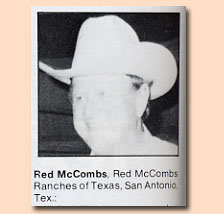 Red McCombs, Red McCombs Ranches of Texas, San Antonio, Texas
Red McCombs, Red McCombs Ranches of Texas, San Antonio, Texas
"I feel like I was somewhat involved in bringing attention to the Butler line when I first got into the breed seven years ago." In 1979, Red bought half-interest in the now-famous herd sire Classic from Blackie Graves, then created the Classic Syndicate. McCombs is also using Jumbo Horns (son of Bevo) and Redmac Beau Butler (by Classic and out of FM Graves 107), which was raised by McCombs Ranches. On the horizon is a new herd sire Classic's Thunder, a multicolored son of Classic with a 55-inch horn spread.
"Butler's blood is very much a part of our breeding program. We have Butler blood in 60 percent of our herd. We keep a quarter of our Butler cows for a straight Butler herd, and the other 75 percent of our Butler cows are used for outcrossing. It's obvious that the Butler cattle produce horn, and the market has recognized horn as an important characteristic of the breed. Also, coming from the coastal area of South Texas, the Butler cattle are probably the most disease-resistant Longhorn family. The parasites are probably as prevalent in the coastal area of Texas where the Butler cattle thrive as anywhere in the world.
"There's a great advantage in having all seven of the Texas Longhorn families for outcrosses from one family to another. You take the strength of one and match it with the strength of another."
Tom Davis, Davis Ranch, Brigham City, Utah
Tom acquired two of the cows that the late Virgill Shinn of Idaho bought from Milby Butler in the 1960s, both of which produced calves right up until they died at age 17. He has bought later generations of the Shinn's Butler cows, and is now raising the fourth generations of the Shinns' Butler cows, and is now raising the fourth generation. "The Shinn cows had very good conformation and nice horns, but not fantastic horns.
"Some say that Butler cattle are awfully fine-boned. I think some of the cattle today are a little large and coarse and the conformation of the Butler cattle is what a Longhorn should be. Along with the purity and the conformation, I like the horns. If you're going to have Longhorns, you should have long horns on them.
 Sammy Meshell, Meshell Longhorn Ranch, Trinity, Texas
Sammy Meshell, Meshell Longhorn Ranch, Trinity, Texas
"I started with cows from the Butler estate." Sammy and his brother DeWitt started as partners in the Longhorns, but in a few years divided the herd between them. When asked about some of his early Butler cows, the list Sammy gives is impressive. "I had Droop Horns, dam of Superior, and I later sold her to Darol. Some of the others were Red Neck, Brown, Emmy, Little Emmy and Big Horns. As far as bulls go, I've had Blue Horns, Mister Frost, Little Man and Lone Ranger, which I bought from Butler. He was a brown bull and produced three herd sires with over 40-inch horn span. Butler picked him out as a yearling from a twisty-horned brown cow. She threw a lot of twist, and she had a double twist to her horns.
"Droop Horns had the best corkscrew horn of any cow...her horns were growing into a third twist. Superior's passing on a lot of corkscrew already.
"Without a doubt, the Butler cattle grow horn faster than any other bloodline. I have not one gripe about them. They're good milkers, calve every year, the bulls are good and fertile. They very definitely represent the breed. I looked at the program when Milby Butler was alive, and they're definitely not a freak. I believe in them 100 percent."
Crockett Leyendecker, Leyendecker Longhorns, Columbus, Texas
"I find by crossing Butler with WR and Marks, I seem to get some hybrid vigor - I get more size than with either." Crockett has several Butler cows by Classic, Bold Ruler and Sam, as well as Marks and WR cows. His herd sires are General Lee (by Classic and out of Twist #21, a Marks / WR cow with 57-inch horns) and 1L Richard Twist.
"Personally, I like my herd to carry 25 percent Butler blood. I see good points that I want to incorporate. The Butler cattle were intensely linebred ad by outcrossing, I get a better product than with either family."
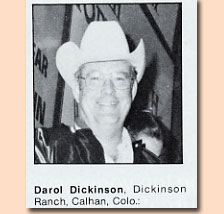 Darol Dickinson, Dickinson Ranch, Calhan, Colorado
Darol Dickinson, Dickinson Ranch, Calhan, Colorado
"I suppose in the last few years, our Butler cows have influenced our program as much as or more than our Butler bulls. About a third of our embryo program consists of Butler cows." In 1972, Darol went to southeast Texas and purchased three cows from Blackie Graves. Two years later, he purchased some more of his foundation Butler cows from Luman Holman. Darol's original herd was largely WR, and he crossed his Butler cows with WR / Ranger bulls. His herd today is predominantly the same three families. His more notable Butler cows have been Mona Lita, Ghost (sold to Wick Comer), Constant Comment, and Red Rose, dam of Sweet ' n Low, who reached 48-inch horn length at two years and set a record for her age. Darol has owned several well-known Butler herd sires, including Colorado Cowboy, Conquistador, Man O'War, Bold Ruler and Bold Brass. He holds one-third interest in Rural Delivery and has bought into the Classic Syndicate. He notes that more sons of Classic have been used as herd sires than any other bull.
"Butler cattle are sort of like the WR in that they're small. I think they're the two smallest families and have the least amount of color, but without question the most horn. Certain Butler cattle have quite a bit of size, though. Ghost is over 1,400 pounds. Some Butler cattle are kind of low in the back and light boned. They generally have a good disposition."
Robert King, New Braunfels, Texas
"With the popular Butler family sires, particularly some of Beauty, I feel breeding to straight Butler cows or other cows, your degree of success is much higher than with any other family of Longhorn. You get a higher percentage of desirable calves that will bring high dollars. Look around at all the sales and shows and you'll see it's true."
In his four years in the business, King has used most of the prominent Butler sires, either in natural service or A.I. He recently acquired Butler Boy, by Bevo and out of Beauty, and full brother to Classic.
"Butler bulls are in my experience, more aggressive breeders....definitely down to business. I've spent a lot of time studying Butler cattle, and I've never seen a Butler bull that is not abnormally aggressive. I wouldn't hesitate to stick one with 100 head of cows and he'd have 'em covered in three months."
 Jean Wickland, Broken Arrow Ranch, Franktown, Colorado
Jean Wickland, Broken Arrow Ranch, Franktown, Colorado
"I think the Butler cattle are maybe a more typical Longhorn than some of the other families. They're a cleaner animal. I like that breeding a lot." That would seem obvious, since Jean purchased Bold Ruler in 1980. By Sam and out of Miss Dayton, Bold Ruler has been one of the most influential Butler bulls. His progeny have been grand champions and high sellers at numerous shows and sales, and he has produced some outstanding herd sires. About 50 percent of Jean's herd is predominantly Butler blood, and the rest are largely WR and Texas Ranger cows.
Jimmie Grieve, Dumbell Ranch Co., Wheatland, Wyoming
"Owen (McGill) and I decided we'd go into the Longhorn business a little bit, just to play with. I sent him to Texas to look around, and he bought 13 heifers from Schaleben." Owen and Jimmie then bought Bold Ruler at the Denver Stock Show. "Neither Owen nor I knew much about bloodlines at that time. With his conformation, color and horns, we just thought Bold Ruler was what a Longhorn bull should be."
Jimmie got three calf crops out of Bold Ruler before he and Owen sold him to Chico Wright. "When we traded him to Chico, we didn't know what we had. So we peddled him for about a tenth of what Chico got for him a couple of years later. Every time Owen and I talk about it, we lament the fact that we sold him. But it takes five or six years at the very least to tell what a bull will do.
"But I never sold a Bold Ruler female. I sold off my old foundation cows and kept the Bold Ruler cows. I'm using Matador for a herd sire now. He's a son of Bold Ruler out of Keechi Valley 78 and has a 52-inch horn spread. I think the long horn is the only true Longhorn trait.
Agee Spidle, Spidle Ranch, Vernal, Utah:
"The Butler line originated 30 or 40 miles from where I was raised. I think they're very representative of those East Texas cattle." Agee's main herd sire has been Bold Ranger, a one-quarter Butler bull. He's getting his first calf crop from Classic, Jr., by Classic and out of Graves 53, a coming five-year-old with 51-inch horns, which he bought from Owen McGill, who purchased him from Blackie Graves.
"I've got Bold Ruler daughters with good conformation and they're good milkers, but they have a tendency to throw white calves. We sure do get the horn growth out of 'em, though. I'm getting my third calf crop out of Bold Ranger. His calves are real colored with a lot of horn."
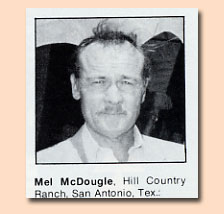 Mel McDougle, Hill Country Ranch, San Antonio, Texas
Mel McDougle, Hill Country Ranch, San Antonio, Texas
"I've emphasized the Butler bloodline for the past three years. I got into them because of the accent on horn growth. I find them to be very prolific, very certain and predictable in production and progeny."
Mel is one of the principles in the newly-formed Bevo semen syndication. In addition to Bevo, (sire of Classic), he has used Superior, Blue horns, Classic and Butler Boy in A.I. For natural breeding on his ranch, Mel has used Baron Classic, JVC Wichita Classic and Jumbo Horns, Jr. Sixty percent of his herd is made up of cows that are at least half-Butler.
 Phil Wilson, Teton Valley Ranch, Kelly, Wyoming.
Phil Wilson, Teton Valley Ranch, Kelly, Wyoming.
"I'm getting wild colors in my Superior calves. The bull tends to accent the cow. We've gotten very few white calves out of him." Phil leases Superior every summer from Sammy Meshell. Superior is sired by Blue Horns out of Droop Horns and boasts a 52 1/2 inch horn spread. Phil also used TVR Condor, a son of Conquistador which he bought as a calf from Dickinson Ranch.
"One of the reasons the Meshell's cattle are doing so well is that they reflect the original size of the Butler cattle. Superior is far and away one of the best examples of this. He weights over 1,800 pounds, and he's going to take it back to the Butler cattle of the 1940s. He's representative of Butler cattle before they got so inbred."
Bob Shultz, Prairie Canyon Ranch, Franktown, Colorado
"My bull, Colorado Cowboy, is by Conquistador, and it's quite a different strain than Classic...different conformation." Bob bought Colorado Cowboy as a baby five years ago. Half of his cows are at least 50 percent Butler blood.
"I particularly like the gentle disposition that's noticeable and consistent in the Butler line. And I like feminine cows that don't get over 950 pounds at maturity. Colorado Cowboy and Bold Ruler throw very feminine daughters. Naturally, I'm interested in mothering instincts, but I kind of take that for granted.
"Colorado Cowboy crosses well with WR, which I have quite a few of. My Cowboy daughters are right beside Bold Ruler daughters on horn.
Jean Shinn, Quarter Circle Ranch, Idaho Falls, Idaho
"In April 1966, my father, the late Virgill Shinn, bought a nice big Butler bull and four heifers from Milby Butler, and Mr. Butler threw in a steer, too." Jean still keeps a small herd of cows, on which she uses Classic Gold, a Classic son purchased from Tom Davis. Jean sold one of the Shinns' original Butler cows to Davis, and the cow produced right up until she died at age 17."
"The Butler cattle definitely had horn of their own. I think out of the seven Longhorn families they're one of the oldest, and I really feel they're more or less the typical Longhorn."
Dr. Ed Stephenson, D.V.M., Stephenson Longhorn Ranch, Liberty, Texas
"Back in 1981, I bought 34 Longhorn cows from Ed Stein, and 17 of them had 40-inch or more horns. Ed Stein had bought out a Mr. Stark, who got his Butler cattle straight from Milby's herd. I had doctored Milby's cows and those were the only Longhorns I knew of. I bought my bull Reveille in 1977 from Pauline Russell. He's a full brother to Classic, but he's more masculine -- bigger, taller and longer."
Ed compares the Longhorns in his part of Texas to Mexican long-horned cattle, which are small with lots of horn. "Longhorns varied as much in the old days as they do now, based on location. We can't raise as big an animal down here. This is hot, humid, rough country. I think this maybe had something to do with the horn growth. But Milby Butler definitely had a knack for selection."
 Maribeth Vineyard (shown with Michael McLeod), Vanderbilt, Texas
Maribeth Vineyard (shown with Michael McLeod), Vanderbilt, Texas
"I'll tell you what, I never saw a worse-looking bunch of cattle in my life." Thus, Maribeth describes the Butler cattle that she bought in 1977 at the urging of her partner, Michael McLeod. They were Brahma breeders, but Michael had wanted to have Longhorns since childhood. Don Jobes, Houston Stock Show manager, and his wife were selling the Longhorns she inherited from her father, Forrest Leper, who got them when Butler's herd was dispersed. Michael convinced Maribeth to buy the bunch, which included the bull Thomas.
"It had been a hard winter, and those Longhorns were underfed and sorry. I thought Michael was crazy. Our feed bills were already sky-high, and I sure didn't need more cattle to feed."
Maribeth got over her resentment two years later when she read Darol Dickinson's article on the Butler bloodline in the Texas Longhorn Journal. "I finally realized their value. It has turned out to be one of the best investments, an I didn't want to do it at all. Longhorns are so much cheaper to raise than Brahmas it's not even funny." She has sold all her Brahmas.
"I'm using a He's A Ten, a 50-inch bull by Thomas."
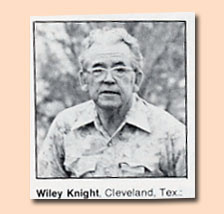 Wiley Knight, Cleveland, Texas
Wiley Knight, Cleveland, Texas
"My wife and I are real happy with the Butler cattle," says Wiley, who happened onto a few Longhorns that would make anybody happy. When new to the Longhorn business, Wiley impulsively bid on a young heifer at a commercial sale ring, and wound up with Party Girl, a Partlow cow by Conquistador. This good-horned Butler cow produced a heifer with an 11-inch horn base at 34 months. "People who've been in the Longhorn business a lot longer than I tell me that's got to be a record."
Then in 1977, Wiley got a call from Pauline Russell and her husband, whom the Knights knew through church. "They told me they were selling off their Longhorns at auction and if I wanted a good herd sire to buy the red-and-white two year-old That's what I did, and I didn't even bid on Classic or the other bulls Pauline was selling."
He named the bull Butler Boy and later sold him to Red McCombs at a price which "broke Impressive's $60,000 record by a wide margin." Butler Boy has a horn base of 15 inches.
At the same auction, Wiley acquired Lady Butler, only known daughter of Bevo and Beauty, and only sister of Classic.
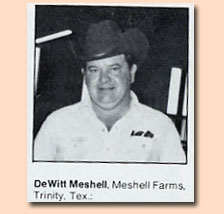 DeWitt Meshell, Meshell Farms, Trinity, Texas
DeWitt Meshell, Meshell Farms, Trinity, Texas
"Good, feminine Longhorns are what the Butler cattle are." DeWitt knew Milby Butler in the 1960s, and bought some of the Butler cattle at an auction after Milby's death. He bought Bevo, sire of Classic, from Ruel Sanders in 1980.
"Bevo was no doubt one of the greatest bulls Butler had. He brings in the old Texas Longhorn blood. He had the twist to his horns. He wasn't a lateral-horned bull at all. The horns on his calves are real twist blood." Bevo is deceased, but DeWitt is now involved in syndicating his semen.
"In all cattle, you're going to have some impurity, but the Butler cattle have a lot of purity. They throw twist horns and lateral. As far as conformation goes, they're a clean, feminine cow. You can breed them to the other bloodlines and they'll give the offspring these same qualities."
Rex Hollenbeck, Hollenbeck Longhorn, Lentner, Missouri
"My Butler cows are a smaller part of my herd, but they're the best part. I bought some cows from Owen McGill that were carrying Bold Ruler calves, so now I have several Bold Ruler daughters. I like Bold Ruler best of all the Butler bulls. His calves are straight, correct and carry considerably more color. He has dark pigment on his skin, and that passes on. He throws big-horned calves, which is the strong point on the Butler line. I've gotten from $4,700 to $8,500 for some of my Bold Ruler daughters."
Material is courtesy of LonghornJournal.com